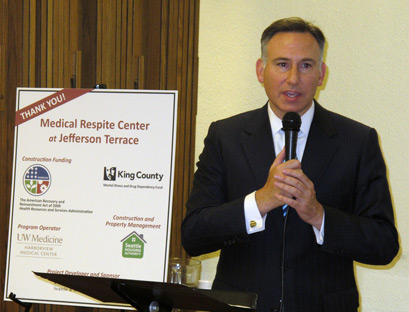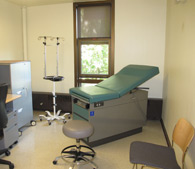
 SEATTLE — August 3, 2011 — Recovering from hospital treatment is hard enough, but where would turn if you were living on the street or in your car? This is the role of medical respite: a safe place to heal for the homeless.
SEATTLE — August 3, 2011 — Recovering from hospital treatment is hard enough, but where would turn if you were living on the street or in your car? This is the role of medical respite: a safe place to heal for the homeless.
The Seattle Housing Authority is proud to be hosting the newest respite facility in King County at Jefferson Terrace, according to Executive Director Tom Tierney. Tierney spoke Tuesday, August 2 at the grand opening ceremony for the Medical Respite Center at Jefferson Terrace at the building.
Seattle Housing converted one floor of this public housing building from residences to institutional space for the Respite Center, to be operated by Public Health-Seattle-King County and staffed by Harborview Hospital. The first clients will be accepted in September 2011.
The respite care facility is a stand-alone program within the walls of Jefferson Terrace. There are separate entrances, dedicated staff and a distinct mission. Traditional public housing has been offered here since the 17-story, 289-unit building opened in 1967.
"Respite expands our service to the community's homeless population in a new way. It is part of the Seattle Housing Authority's contribution to the Committee to End Homelessness' Ten Year Plan," Tierney said at the opening.
Jefferson Terrace already hosts another stand-alone program, Full Life Care, which provides eldercare community services from the sixth floor. "
King County Executive Dow Constantine, who co-chairs the Committee to End Homelessness, also spoke at the event. He stressed the important role that respite plays in meeting goals of the County's strategic plan. The program improves healthcare, uses hospital emergency care resources wisely and helps contribute to a more just and fair society, he said.
"Here is an excellent example of our medical, behavioral health and housing partners coming together to maximize our resources, coordinate care, and create opportunities for better health and stability for a very vulnerable population."
Once the plans for respite care on the seventh floor were in place, apartments on the floor were left vacant as residents moved.
Remaining residents of the original 22 studio apartments on the seventh floor were relocated as needed in preparation for construction, which began in March 2011. Building residents were involved throughout the planning and construction process to make sure that the blend of services in the building would be workable for all residents.
Existing apartments were redesigned to offer temporary sleeping and recuperation quarters in a semi-private configuration, with more than one occupant per room. The kitchens in the apartments were removed to make room for two or three beds.
Other units were turned into a community room for common meals, a laundry, and a program offices. The two-bedroom unit became an examination room and interview rooms where clients will be referred to mental health care and permanent housing options elsewhere.
The most noticeable modification for this project was the construction of an entirely new elevator that runs directly between the Medical Respite Center's outside entrance at the sixth floor street level and the facility on the seventh floor. Other modifications include cameras installed in the hallways to help with security during the 24/7 staffing in this controlled access facility.
Admission is by referral only, with no walk-up services. Admission to the facility is meant for people who are well enough to be discharged from the hospital, but have nowhere else to go.
"What Respite offers a homeless person is a safe place to recover from injury or illness, connect with services and work on a better housing plan for the future," explained Chris Hurley, who managed the project's implementation for Public Health-Seattle-King County.
A capital grant from the U.S. Health Resources and Services Administration (HRSA) provided the seed money to fund the conversion, along with contributions from the King County Mental Health Fund. Operating costs will be covered by a consortium of King County hospitals that will refer clients discharged from hospitals or emergency room treatment to the program.
